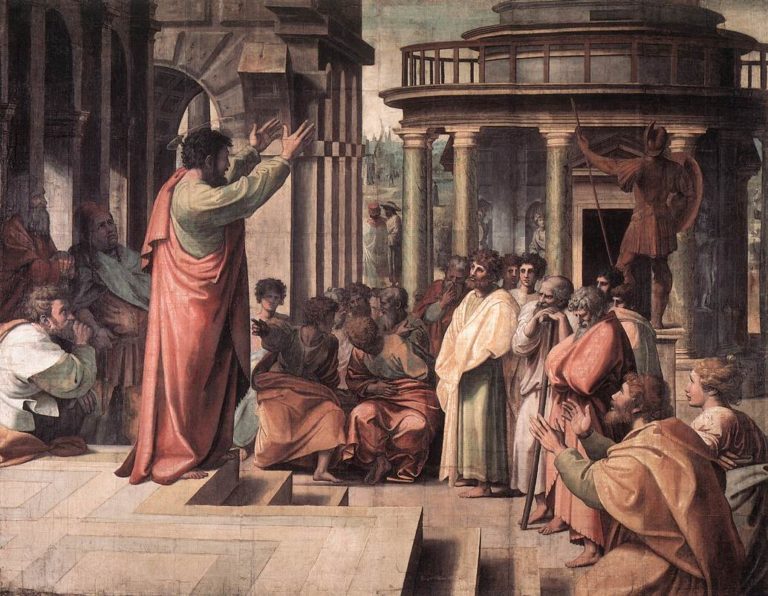The Seven Liberal Arts
The framework of a classical education is the liberal arts. The word “liberal” is from the Latin word liberalis, relating to a free person. At another time we’ll look at what it meant to be a free person in the classical world, and what a liberal arts education frees one from. At this time we’ll look at what the liberal arts are. There are seven liberal arts: Grammar, Logic, Rhetoric, Arithmetic, Geometry, Music, and Astronomy. The seven liberal arts are distinguished by two subcategories: the trivium (tri – three) and the quadrivium (quad – four). To explain the distinction in the simplest way possible we might say that the trivium focuses on letters and the quadrivium focuses on numbers. In this article I’ll explain the trivium.
The Trivium: Grammar
We can think of the trivium in terms of architecture. First the architect must understand his building materials and tools. In language this involves learning the alphabet, learning how to combine letters into phonenes and phonemes into words and words into sentences. Vocabulary is the lumberyard and quarry. Syntax is the mortar, the nails. The first art of the trivium is Grammar, which teaches one to select the proper pieces of wood, pick up a hammer, and stick a few boards together in a useful and orderly fashion.
Learning grammar inevitably includes whacking thumbs and dropping bricks and prying out bent nails. There are important distinctions to make, and mastering them takes time and frustration and fortitude. Pronouns have different declensions depending on their role in a sentence: I, he, she for subject; my, his, her for possessive; me, him, her for direct object. Verbs sometimes conjugate predictably: walk, walking, walked. Sometime verbs conjugate quite unpredictably: be, were, was, been, am, is, are; go, goes, went, going, gone. There are transitive verbs and intransitive verbs, and many of us still bruise our fingers with lay (transitive) and lie (intransitive) – “he lays the baby in the crib and then lies in bed.” There’s punctuation and spelling and learning to count syllables. When is it “less” and when is it “fewer”? When “your” and when “you’re”?
The teacher mercilessly drills the basics. Each question has its set answer that is not up for discussion or debate. It is not that the teacher devalues self-expression. The teacher simply recognizes that without basic grammar the students cannot adequately express themselves. So in love for the students and desiring to impart a great gift the teacher says, “Shut your mouths and open your ears. This is how it is.” Drill, drill, drill, drill, drill.
This is exhausting work, but when the junior architect builds his first little wooden bridge or stone wall, when he spells every word in a sentence correctly and properly aligns persons and numbers and tenses of the nouns and verbs, when the bricks are level and the studs equally spaced – well! there is great satisfaction, and a healthy pride, and hope for this great undertaking of language.
Logic
The second art of the trivium is Logic, also called Dialectic. This art has to do with reason and argumentation. In Logic the student learns to make sound arguments and analyze the arguments of others. A key tool for this process is the syllogism, which consists of a major premise, a minor premise, and a conclusion. To give an oft-used example: All men are mortal. Socrates is a man. Therefore Socrates is mortal. That syllogism is both valid and sound: valid because the conclusion flows logically from the premises, and sound because, in addition to being valid, the premises are also true.
I could say: All cats can fly. I have a cat. Therefore my cat can fly. It is a valid argument, but neither of the premises are true, and therefore the argument is not sound. It would be like building a staircase out of balsa wood. Yes, it’s a staircase. But it’s going to collapse under me if I try to climb it. Or I could say: All people who eat at Olive Garden are happy (see how they smile in this commercial?). You want to be happy. You should eat at Olive Garden or you will never be happy. The logic behind a syllogism like this is the equivalent of cutting a hole in the upper story of a house and calling it a staircase. More frequently it goes by the name “advertising.”
In Logic the junior architect learns how to join walls and dovetail beams, to pattern trusses and support ceilings. While in Grammar he learned to make window frames and lay floorboards, in Logic he combines these elements to make rooms, and creates passages between the rooms and the various floors. The solid structure of a house results. The teacher drills the forms of syllogisms and gives many examples of good and bad arguments. When the students are not reciting forms and logical fallacies they’re debating.
And they’re not stuck in childish debates, like whether pepperoni or pineapple makes a better pizza topping. No, they can go beyond mere subjective preferences. They’ve been instructed in Grammar and Logic, and moreover have studied these arts through good literature that has instilled good moral virtue. They can argue about right and wrong, better and worse, without having to rely on their personal opinions. Never will they say, “That might be true for you, but it’s not for me.” They have become acquainted with the real world, the world of absolutes, the world where a statement can be objectively true or false. They have learned to navigate this world and speak its language. The strength of their architecture shows it.
Rhetoric
The third art of the trivium is Rhetoric, perhaps most simply defined as the art of persuasion. In tandem with sound arguments, Rhetoric moves an audience toward what is good and true. Bare Logic might say, “Here’s a bedroom, and bathroom, a kitchen, a living room, and a laundry room. You have everything you need. Move in.” Logic isn’t wrong in thinking that people should believe its arguments on the basis of soundness and truth. Logic can be something of a pragmatist if we leave it alone. “You need a table? Ok, here’s a barrel with a scrap of plywood on it. A table.”
But Rhetoric says, “No, friend Logic, not like that. I agree with your design. A flat surface on a support, that’s good. That’s sound. But use this mahogany for the table top. Let’s cut it into a circle, bevel the edges, stain it, and varnish it. And let’s use a thinner support. I’ll spin something on the lathe. Ah, yes, see how it complements the top! It’s much more pleasing, and now you don’t bash your knees on the support when you sit down.”
That’s what Rhetoric does. It weaves thoughts and arguments into a cohesive whole, it removes unnecessary stumbling blocks, it beautifies Logic and pleases the audience. Rhetoric runs through the house and puts arches over doors and exotic wood on the floors. It dresses stones for the exterior walls, landscapes the yard, builds columns with Corinthian capitals for the porch. And when the junior architect has been trained in Rhetoric, he’s no longer a junior architect: he has what he needs to be a master. The student can choose the one right word out of a million and put it in service of sound logic and adorn truth with the beauty that truth deserves. The student can analyze, respond, express, and convince. When lies come calling in their pretty disguises he can spot them instantly, strip back their sequined cloaks, and show them for what they are. And meanwhile, from his mouth and his pen the student sends goodness and truth and beauty into the world.
Restore the Trivium
This sort of student, this sort of architect, has become a rare creature. Many who have some small command of rhetoric put it in service of invalid and unsound arguments. Many more don’t understand enough logic to tell truth from lie. What happened? Two main things. First, in many schools objective truth was told, “It’s a nice day outside. Why don’t you take a walk and, uh, don’t come back.” The history and consequences of this deserve several articles, and we needn’t delve into these details as we near the end of this one.
The second reason why logicians and rhetoricians are rare is that in many schools self-expression has become the starting point of education and not one of its ends. “After all,” educators argue, “who wants to diagram sentences and learn about glottal stops? Here’s a piece of paper and a pencil. Write a story. Tell me about your favorite color.” This is like giving a man a clarinet and saying, “Play this instrument. Express yourself.” All that follows is squeaking from the clarinet, frustration from the man, and a desire for earplugs from everyone who must listen to him. But because this has been going on for so long, we don’t even desire the earplugs anymore. “Hey, not bad,” we say. “You sound like the rest of the clarinet players.”
But where has this left us? We can’t engage in an argument without taking it personally. We lack the logic necessary to make a case or critique one. Civil discourse seems to exist in name only. And it’s not that persuasion has stopped. It’s that persuasion has fallen to the level of base manipulation. Without good logic or rhetoric we are forsaken to the winds, blustered about by slogans and soundbites. We’re subject to pithy statements whose conclusions have no premises. These slogans tickle the ears and achieve some emotional effect. Men with wrecking balls point at a cardboard box and say, “Look at this mansion! It has everything you need. It’s a lovely place. You should move in.” And to their own harm many do.
Our children deserve better. We owe them better. So let’s give them the trivium. Let’s teach them to hew stones and plane boards. Let’s teach them to build houses and town halls and cathedrals. Let’s make them reasonable and eloquent in matters of home and state and Church. And while we’re at it, let’s abandon our own shabby boxes and aspire to something better.
Originally published at Corridor Classical Education
Painting: “St. Paul Preaching in Athens” by Raphael, 1515


